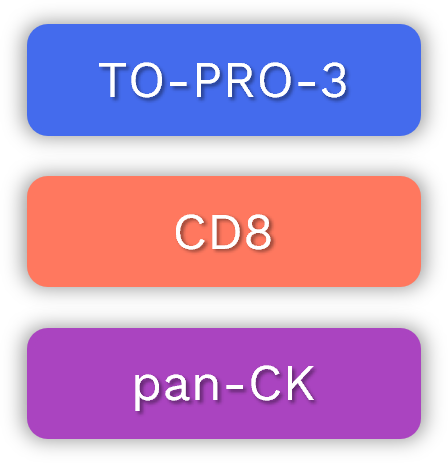3D Immuno Oncology insights with the 3D I/O Pro™ Assay.
What is the 3D I/O Pro™ Assay
3D digital pathology assay for the tumor immune microenvironment
The 3D I/O Pro™ assay is a 3D digital pathology assay for the tumor immune microenvironment. It combines high resolution 3D tissue imaging with quantitative analysis to deliver:
Tumor classification into hot vs cold phenotypes
Immune exclusion characterization at the tumor margin and core
Collagen orientation and structure in the tumor and stroma
Tertiary lymphoid structure (TLS) detection and quantification
Lymphocyte quantification and spatial mapping in 3D
The assay is built on the Aurora™ 3D spatial biology platform and is suitable for solid tumor indications where immune contexture and collagen structure matter.

Why 3D tumor immune microenvironment imaging matters
3D tissue imaging captures the full tumor volume and makes it possible to:
Visualize lymphocyte gradients from periphery to core in three dimensions
Assess immune exclusion across the entire tumor, not just a single section
Quantify TLS volume, shape, and proximity to tumor nests
Characterize collagen orientation and density in the tumor and surrounding stroma
Standard immuno-oncology workflows often rely on:
Thin 2D sections that sample a small portion of the tumor
Single plane views of lymphocyte distribution
Limited ability to visualize TLS volume and structure in context
With 3D I/O Pro™, these features are converted into quantitative spatial profiling metrics that support mechanism-of-action studies, biomarker discovery, and translational research.
3D I/O Pro™ Assay Workflow
The 3D I/O Pro™ workflow is built on the Aurora™ 3D Spatial Biology Platform.
3D tissue imaging with the 3Di™: Tumor samples are imaged on the Hybrid Open-Top Light-Sheet Microscope, which provides high-resolution 3D tissue imaging across whole blocks.
Data Management with 3Dm™: Large 3D datasets are ingested into 3Dm™ for automated data management, stitching, correction, and volume generation
AI-powered Analysis with 3Dai™: 3Dai™ applies AI and machine learning models to segment tumor regions, collagen, lymphocytes, and TLS. It computes metrics such as hot vs cold classification, immune exclusion indices, TLS volume and location, collagen orientation, and 3D lymphocyte densities.
3D I/O Pro™ Assay
Marker panels for immuno oncology
Different immuno-oncology programs require different panels. The 3D I/O Pro™ assay supports both pre optimized and custom marker strategies.
Option A
Select a pre-optimized panel
(Example markers shown)
Option B
Design your panel
Our platform supports easy marker swapping to accommodate the evolving needs of your experiments. We offer optimized markers for multiple species, including humans and mice.
Example 3D immuno-oncology datasets
Memory T cell identification with CD45RO
3D imaging with CD45RO staining enables the identification of memory T cells within thick tissue.
Human colorectal cancer sample
A 3D view of human normal adjacent colorectal cancer, stained with a nuclear dye and an anti CD8 antibody, demonstrates how the assay maps CD8 positive T cells relative to tumor regions and stroma in three dimensions.
Who uses the 3D I/O Pro™ Assay
The 3D I/O Pro™ Assay supports teams working in:
Immuno oncology research and development
Studies of immune exclusion and hot vs cold tumors
Translational programs focused on the tumor immune microenvironment
TLS, collagen, and stromal structure in relation to response
Applications include mechanism of action studies, spatial biomarker discovery, and exploratory imaging endpoints in solid tumor studies.
Getting started with 3D immuno oncology imaging
You can access the 3D I/O Pro™ assay in several ways.
3D histology imaging services
Send tumor samples to Alpenglow Biosciences for full-service imaging and analysis.
Aurora™ 3D spatial biology solution in your lab
Implement the 3Di™, 3Dm™, and 3Dai™ modules in your own environment to run immuno-oncology assays in-house.




